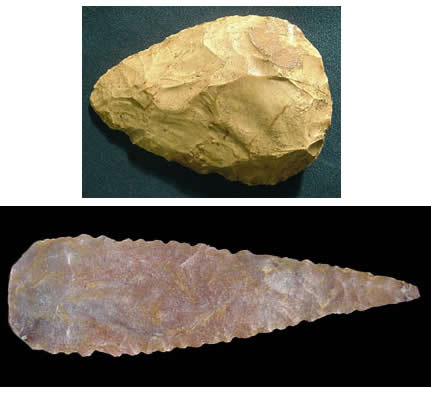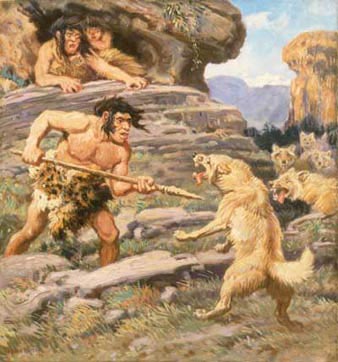Long gone are the days of using the term "Neanderthal" as an insult; a term for a stupid, brutish oaf. At least according to archaeologist Thomas Wynn and psychologist Frederick L. Coolidge of the University of Colorado. In the April 2004 issue of the Journal of Human Evolution, these researchers propose that the differences between Neanderthals and modern humans are not based on one species being intelligent and the other simple-minded, but rather a fundamental cognitive difference in how each species approached life at the end of the Ice Age, and that this difference allowed modern humans to proliferate while the Neanderthals were eventually reduced to extinction. One key aspect of this distinction were differences in personalities between the two species; that everything from language capacity to relative sense of humour may have played a role in the demise of Neanderthals and subsequent success of modern humans.
According to the majority of anthropologists and archaeologists, Neanderthals and modern humans are two distinct species. While Neanderthals appear across Europe from 800,000 years ago, modern humans represent a more recent migration out of Africa 150,000 years ago. As such, when modern humans arrived on the scene in Europe no earlier than 50,000 years ago, they began to inhabit an area of the world that had been home to Neanderthals for hundreds of thousands of years. Whether these two species experienced direct or indirect contact with each other is still under fierce debate. What is clear, however, is that modern humans possessed something extra that allowed them, over a period of only 20,000 years, to push the Neanderthals to the fringes of Europe and eventually to extinction.
Pooling their knowledge of the archaeological record and cognitive psychology, Wynn and Coolidge propose that the main difference between the two species lies in their basic problem-solving abilities. Specifically, they describe Neanderthals as exhibiting what they term "Long Term Working Memory," which includes the ability for advanced stone tool knapping, declarative knowledge of these skills, and the ability to vary these skills to an intermediate level. Indeed, being able to survive in the harsh environment of Europe during the last Ice Age requires not only physical strength and endurance, but intelligence as well, and the Neanderthals were successful for hundreds of thousands of years in this environment.
On the contrary, Wynn and Coolidge argue that modern humans exhibit "Enhanced Working Memory." They theorise that a genetic mutation in modern humans 50-100,000 years ago enabled an enhancement of problem-solving skills that led to innovative and experimental thinking, allowing humans to succeed in Europe, at the expense of Neanderthals. In fact, there are several archaeological examples that may lend support to this theory. For instance, Neanderthals were known to live their lives on a geographic scale of 20-30 km, much smaller than modern humans of the same time period. Further, they appeared to have trouble coping with large interregional spaces. Instead, they were better suited to smaller inhabitable areas, a more common landscape in Ice Age Europe. This inability to cope with a changing environment may have been once factor leading to the disappearance of the Neanderthals.
 |
| Figure 1: A comparison of Neanderthal and Modern Human Stone Tools. The Mousterian Tool tradition (above) is much less complex than modern human traditions (below). Wynn and Coolidge argue that complex tool design is evidence of more complex thought or "Enhanced Working Memory." |
In addition, the stone tool technology used by Neanderthals did not develop at as quick a pace as that of modern humans. Although Neanderthals did eventually develop technology that was similar to modern humans (whether by direct or indirect contact is uncertain), their tools never exhibited the same level of complexity and innovation that comparable modern human stone tools exhibited (Figure 1). Wynn and Coolidge argue that these are primary examples of the Neanderthals' Long-Term Working Memory vs. modern humans' Enhanced Working Memory.
These researchers take their theory even further, to discover what Neanderthals' personality may have been like. Although some, such as Ian Tattersall of the American Museum of Natural History, argue that "we have no idea what the Neanderthals were like temperamentally: whether they were aggressive or retiring; cooperative or individualistic; forthright or sneaky; trusting or suspicious; crude or lovable," Wynn and Coolidge argue that any insight into Neanderthal personality is not this bleak. Rather, it can be inferred from an interdisciplinary look at both the archaeological record and neuropsychological theory.
First, with regard to hunting, it is commonly agreed that Neanderthals were close-range hunters, using spears to take down large game, as opposed to modern humans, who were developing long-range weapons (i.e. sling shots) during the same period. Therefore, Neanderthals were in a sense "opportunistic". Wynn and Coolidge have inferred that such personality traits as bravery, low levels of harm avoidance, and greater difficulty in making cost-benefit analyses may have been typical among Neanderthals.
 |
| Figure 2: In this turn of the century painting by Charles R. Knight, the Neanderthal is shown attacking an animal at close range with a spear. This painting is actually relatively accurate, as it is believed that most Neanderthal groups hunted in this fashion. It was modern humans who took hunting a step further with distance weapons such as arrows and slings; another example of the cognitive difference between the two species. |
In addition, the researchers also proposed possible differences in language between the two species. They argue that Neanderthal speech may have been limited to the declarative ("I'm hungry"), imperative ("Give me food"), and exclamatory ("Help!") modes of speech, with a reduced capacity for interrogative ("Are you hungry?) modes. Because Neanderthals would not have exhibited Enhanced Working Memory as modern humans did, they would have lacked complex, symbol-based thought. In short, the difference between humans and Neanderthals can be described as loquacious vs. laconic.
Finally, Wynn and Coolidge infer the issue of relative senses of humour between modern humans and Neanderthals. Most anthropologists and psychologists steer clear of the question of senses of humour; indeed only Steve Mithen in his book, The Prehistory of the Mind, poses the question, and argues that Neanderthals would not have had a sense of humour. Wynn and Coolidge do not entirely disagree, but argue that Neanderthals instead exhibited a more simplified form of humour that may be based on the physical rather than mental. For example, due to a more limited speech capacity, Neanderthals may not have been party to plays-on-words or puns.
Though some anthropologists like Tattersall argue that making such speculations in the absence of any physical evidence from the fossil record is inappropriate, Wynn and Coolidge have proposed an exciting theory on the real differences between Neanderthals and modern humans. They argue that the fundamental difference in cognitive abilities eventually led to the success of modern humans, and demise of Neanderthals; that creativity and innovation allowed modern humans to survive in a world quickly changing after the long cold of the last Ice Age; a world which would soon warm to an explosion of agriculture and civilisation.









Comments
Add a comment